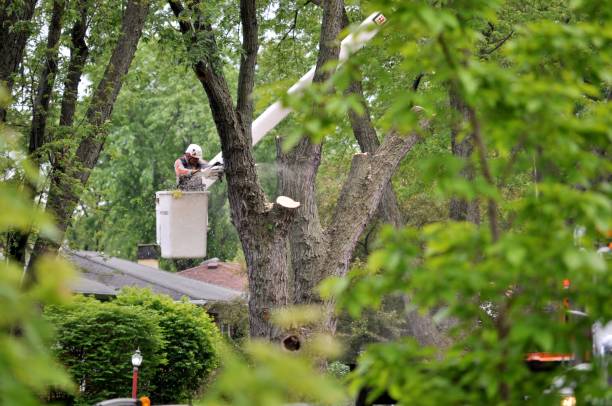Skipping tree maintenance might seem minor, but overgrown branches can cause serious damage during storms.
From costly roof and siding repairs to potential vehicle damage, the expenses can pile up quickly.
On top of that, hidden costs like cleanup and insurance claims can add to the financial strain.
So, how can you safeguard your property and avoid these unexpected expenses?
The Risks of Overgrown Trees and Branches
Overgrown trees and branches can create serious hazards for property and safety, and without proper maintenance, these risks can escalate quickly.
Potential Risks
- Roof and Home Damage: Branches scraping against your roof can cause leaks and structural issues.
- Injury and Property Damage: Weakened limbs may break off during storms, posing significant risks.
- Foundation Problems: Expanding tree roots can crack foundations, sidewalks, and driveways.
- Electrical Hazards: Trees near power lines can lead to outages or dangerous electrical faults.
How to Prevent These Risks
- Regular Pruning: Trim overgrown branches to prevent roof and property damage.
- Tree Inspections: Identify weakened or dead limbs before they become hazardous.
- Root Control: Install barriers to protect foundations from invasive roots.
- Professional Help: Consult arborists for expert guidance on tree care.
These proactive steps can safeguard your property, improve safety, and maintain a well-kept landscape.
The Financial Impact of Storm Damage
Storm-damaged trees can result in unexpected and costly expenses. Addressing potential risks before a storm hits can help you avoid these financial burdens.
Potential Costs
- Home and Vehicle Repairs: Fallen trees can cause extensive property damage, often requiring thousands of dollars in repairs.
- Hidden Expenses: Storm damage may lead to landscaping restoration or higher insurance premiums.
- Professional Services: Emergency tree removal and structural repairs can significantly increase costs.
- Liability Risks: Unmaintained trees can create hazards that result in costly injury claims.
Prevention Strategies
- Regular Tree Maintenance: Trim branches and inspect trees for signs of weakness.
- Storm Preparation: Identify and remove unstable trees before severe weather arrives.
- Consult Professionals: Arborists can assess risks and recommend preventive actions.
By investing in proactive tree care, you can reduce the risk of storm damage and avoid expensive surprises in the future.
Preventative Tree Maintenance: A Cost-Effective Approach
Investing in preventative tree care can help you avoid costly damage while improving your property’s overall appeal.
Key Benefits of Preventative Maintenance
- Early Detection: Regular inspections catch issues like dead branches, disease, or pests before they worsen.
- Reduced Repair Costs: Addressing minor concerns early prevents expensive storm damage or property loss.
- Enhanced Property Value: Well-maintained trees improve curb appeal and contribute to a healthier landscape.
Recommended Maintenance Practices
- Routine Pruning: Trim weak or overgrown branches to reduce storm risks.
- Soil and Root Care: Healthy roots strengthen your tree’s stability.
- Professional Assistance: Certified arborists can identify and resolve potential threats.
By staying proactive with tree care, you protect your property, improve safety, and ensure your landscape flourishes for years to come.
Neglecting tree care can lead to costly repairs, property damage, and safety risks, but proactive maintenance offers a cost-effective solution.
Pruning branches regularly, inspecting for hazards, and seeking professional guidance can prevent expensive surprises and maintain a safe, attractive landscape.
Investing in tree care now can save you thousands in potential repairs while preserving your property’s beauty and value.

